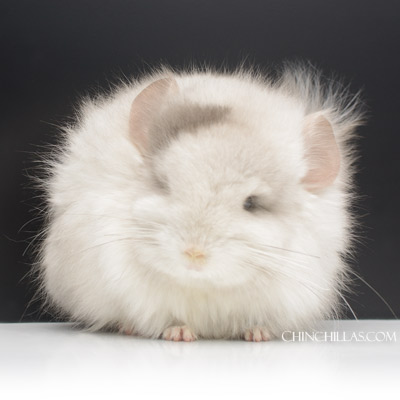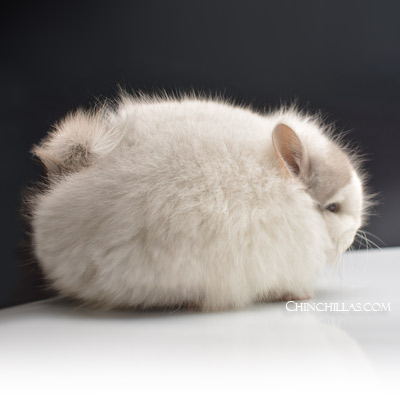The Royal Persian Angora Chinchilla - Originally Long Furred Type, 1966-1987

Prior to the preeminent rise in popularity of hobbyist mutation chinchillas, which occurred in tandem with the founding of Chinchillas.com in 2000, the value of new mutations in the chinchilla industry was weighed according to pelt market value. The subsequent article was written by Dr. J. Lauridsen in 1987, and offers valuable insight into the evolution of the long furred mutation, later renamed the Royal Persian
The Long Furred Type of Mutation of Roy Wilson
by J. Lauridsen, M.D.
There have been at least three places that a long furred chinchilla has developed. One of these was in
 The next time I saw this mutation, or a similar one, was in
The next time I saw this mutation, or a similar one, was in
The “new” long fur type mutation of Roy Wilson is not actually new. The first of his animals that showed evidence of this change was P4, which was born in 1966, which of course was 21 years ago. Of interest in this mutation, however, there was never any evidence of off-color, either in the belly or in the fur of this mutation, although otherwise it looked quite similar to the other mutations. This animal produced carriers and eventually other homozygous long fur animals, and he worked with this mutation for several years. This proved to be a simple 2-gene recessive and some of the carriers but not all of the carriers, showed evidence of the fur being longer than the Standard fur.
Through the years, Mr. Wilson continued to work with it some but in the last few years his friend, Doyle Briscoe has taken over the raising of the mutation and is half-owner. He lives in a little town South of Waco, Texas, and also a little bit South of Temple, Texas. If somebody wants to see these animals, they had better call the ranch, however, because it is hard to find.
Before we discuss the long fur type mutation, we should review fur length in the standard chinchilla which on an average is ¾ to 1 inch in the neck and 1½ inch [to] slightly longer over the buttocks.
As compared with the Standard, this animal has a full 3 inch fur over the rear and 1¾ inch approximately in the neck. It is a rather confusing picture since we’re not used to this. You pick them up by the tail and there is a big bush around the rear-end since the fur lays down in this area, and you have to shake them out and comb them around a little to get used to these. However, in the homozygous state it does not appear that this fur would be of value because not only is the fur much longer than other chinchilla, there is quite a market difference in length of fur from the neck to the rear. He had a few White animals there that had been pelted which had a beautiful appearance, but you couldn’t match them up with anything because the fur was so long that the pelts would not fit into an ordinary coat in a cosmetic manner.
In summarizing the consensus and opinion on this animal:
(1) It is a definite recessive and apparently it is a single gene recessive.
(2) Carriers are marked or somewhat lengthened in their fur shaft in about half or more of the offspring.
(3) The homozygous form probably has too long a fur to have merit in the fur market at this time.
(4) The carrier or one gene animal has fur only slightly to moderately lengthened and has a good appearance as saleable pelt. Actually, this is an important product from a pelting standpoint.
(5) Clarity of carriers and in the homozygous form seems to be good, with good white bellies in contrast to the previous mutations of this type. Average color is medium to dark medium, with no definite darks yet developed.
(6) When crossed to Blacks in
Doyle and Sandy Briscoe [have] worked on the animal in the last few years, and they have a rather excellent herd with good pelt prices. It is expected that a considerable number of the carriers will be sold as pelts and probably they should make rather good pelts, as far as I [can] tell.
 In the last year or two, some of the carriers have been used in shows and the Briscoes have one male Black who is a carrier, who received Champion Black in one of the
In the last year or two, some of the carriers have been used in shows and the Briscoes have one male Black who is a carrier, who received Champion Black in one of the
Accordingly, this mutation in its present understanding is probably a tool to make good pelts with a little more plushness and fur length than other pelts from the same ranch. The problem is, what to do with the homozygous form. Apparently the homozygous form should be used for breeding only and specifically should be bred to fairly dark animals to darken up the carriers, because the fur prices at this time dictate a rather dark pelt to get the top dollar.
Read more about Royal Persian Angoras in the chinchilla gene mutation section of the website.
Visit the Chinchillas.com Auction database to view hundreds of additional pictures of Royal Persian Angora chinchillas, or see new chinchillas for sale in the Sales Gallery.